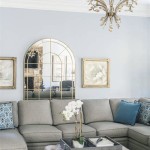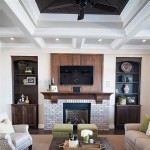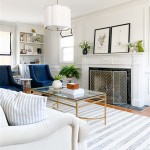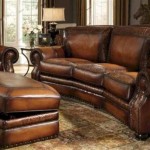Designing a Harmonious Living Room with a Sectional and Chairs
The living room serves as a central hub for relaxation, entertainment, and social interaction within a home. Designing this space effectively requires careful consideration of furniture arrangement, traffic flow, and overall aesthetic coherence. A common and versatile furniture combination involves a sectional sofa and complementary chairs. The strategic integration of these pieces can maximize seating capacity, define distinct zones within the room, and contribute significantly to the room's overall visual appeal. Successfully incorporating a sectional and chairs hinges on understanding their individual characteristics and how they interact within the designated space.
Sectional sofas, known for their modular design and expansive seating, offer a range of configurations to suit diverse room layouts. The ability to arrange sections independently or attached allows for adapting to varying spatial constraints and design preferences. Chairs, on the other hand, provide individual seating options and opportunities to introduce contrasting textures, colors, and styles. When thoughtfully selected and positioned, chairs can complement the sectional, creating a balanced and inviting environment. Optimizing the layout requires considering factors such as room size, natural light sources, and intended use of the space.
Understanding Space and Scale
The foundation of any successful interior design project lies in accurately assessing the dimensions of the room. Before selecting a sectional and chairs, it is imperative to measure the length, width, and height of the living room. These measurements will determine the maximum size of furniture that can be accommodated without overwhelming the space or impeding movement. A common mistake is choosing furniture that is disproportionately large for the room, resulting in a cramped and uncomfortable atmosphere. Conversely, undersized furniture can appear lost and insignificant within a larger space.
In addition to the overall room dimensions, consider the placement of existing architectural features such as windows, fireplaces, and doorways. These elements will influence the layout options and dictate the optimal positioning of the sectional and chairs. Avoid blocking access to doorways or obstructing natural light sources. Instead, use these features as focal points around which to arrange the furniture. For instance, a sectional can be positioned to face a fireplace, creating a cozy and inviting gathering area. Chairs can then be strategically placed on either side of the fireplace to balance the arrangement and provide additional seating.
The scale of the furniture relative to the room and to each other is equally important. A large sectional paired with delicate, petite chairs may create a visual imbalance. Similarly, a small sectional placed in a grand living room will appear dwarfed. Aim for a cohesive look by selecting furniture pieces that are proportional to the room's dimensions and that complement each other in terms of size and visual weight. Consider using furniture planning software or creating a scale model to visualize different layouts before making any purchases. This will help to avoid costly mistakes and ensure that the furniture fits seamlessly into the space.
Sectional Style and Placement
Sectional sofas are available in a wide array of styles, ranging from traditional to contemporary, each with its own unique aesthetic characteristics. The style of the sectional should align with the overall design theme of the living room. A classic, rolled-arm sectional with tufted detailing would be well-suited for a more traditional setting, while a sleek, low-profile sectional with clean lines would be a more appropriate choice for a modern space. Consider the existing architectural details of the room, such as crown molding, wainscoting, and window styles, when selecting a sectional style.
The placement of the sectional is a critical decision that will impact both the functionality and the visual appeal of the living room. In a large, open-concept space, a sectional can be used to define a distinct seating area and create a sense of enclosure. Positioning the sectional with its back to an adjacent area, such as a dining room or kitchen, can effectively delineate the living room space. In smaller rooms, consider placing the sectional against a wall to maximize floor space and create a more open feel. Corner sectionals are particularly well-suited for smaller spaces, as they provide ample seating without taking up excessive floor area.
When determining the placement of the sectional, also consider the orientation towards focal points within the room. Ideally, the sectional should be positioned to face a television, fireplace, or large window with a scenic view. This will create a natural gathering point and enhance the enjoyment of the space. Avoid placing the sectional in a way that blocks access to doorways or impedes traffic flow. Ensure that there is sufficient space around the sectional to allow for comfortable movement and access to other areas of the room. Consider incorporating side tables or coffee tables within reach of the sectional to provide convenient surfaces for drinks, snacks, and reading materials.
Chair Selection and Arrangement
The selection of chairs to complement a sectional offers an opportunity to introduce visual interest and personality into the living room. Chairs can be used to provide additional seating, create distinct conversation areas, and add pops of color, texture, or pattern. When selecting chairs, consider their style, size, and comfort level. The chairs should complement the style of the sectional and the overall design theme of the room. Avoid choosing chairs that are too similar to the sectional, as this can create a monotonous and uninspired look. Instead, opt for chairs that offer contrasting textures, colors, or patterns to add visual depth and dimension.
The arrangement of chairs in relation to the sectional is crucial for creating a balanced and inviting space. Chairs can be placed opposite the sectional to create a formal conversation area, or they can be positioned at an angle to the sectional to encourage a more casual and relaxed atmosphere. Consider using a pair of matching chairs to flank a fireplace or window, creating a symmetrical and balanced look. Alternatively, mix and match different chair styles to create a more eclectic and personalized space. Experiment with different arrangements to find the configuration that best suits the needs of the room and the personal preferences of the occupants.
When arranging chairs, also consider the placement of accent tables, lamps, and other accessories. A small side table placed next to a chair can provide a convenient surface for drinks or a reading lamp. A floor lamp positioned behind a chair can provide task lighting for reading or other activities. Throw pillows and blankets can be used to add comfort and visual interest to the chairs. Consider incorporating a rug to anchor the seating area and define the space. The rug should be large enough to accommodate all of the furniture within the seating area, with at least the front legs of the sectional and chairs resting on the rug. These details contribute to creating a comfortable and functionally effective space.
Integrating accessories such as artwork, plants, and decorative objects can enhance the overall aesthetic of the living room. Artwork can be hung above the sectional or on adjacent walls to add visual interest and create a focal point. Plants can be used to bring a touch of nature indoors and add a sense of freshness to the space. Decorative objects can be placed on coffee tables, side tables, or shelves to add personality and reflect the interests of the occupants. Ensure that accessories are carefully chosen and arranged to complement the overall design theme of the room and avoid creating a cluttered or overwhelming look.
Ultimately, the successful integration of a sectional and chairs into a living room design requires careful planning, attention to detail, and a keen understanding of space, scale, and style. By considering these factors, it is possible to create a harmonious and inviting living space that is both functional and aesthetically pleasing.

Buy Cosmos L Shape Sectional Sofa Set With 2 Lounge Chairs Cobalt Collection At 27 Off Online Wooden Street

Ideas For Living Room Layouts With Sectionals

12 Best Living Room Sectional Ideas For Ample Stylish Seating Decorilla Online Interior Design

Buy Cosmos L Shape Sectional Sofa Set With 2 Lounge Chairs Scarlet Collection At 28 Off Online Wooden Street

How To Arrange Sectionals In A Living Room

Tornama Sectional Sofa Set 112 Microfiber L Shaped 4 Seater Couch With Reversible Chaise And Velvet Accent Chair Modern Convertible Couches For

Best Living Room Sectional And Swivel Chairs

White Sectional Sofa And Navy Accent Chairs The Lilypad Cottage

3 Designer Approved Living Room Setup Ideas And Layout Templates
:strip_icc()/CasaWatkingsMCM-0a1d38fc37b947d2a6a245374f14a87a.jpg?strip=all)
20 Gorgeous Sectional Living Room Ideas








